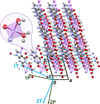issue contents
August 2024 issue

Cover illustration: Françoise Damay [Acta Cryst. (2024), B80, 235–248] provides real case examples for reporting commensurate magnetic structures following guidelines published in this issue. The image shows two-k magnetic ordering of TbCrO3 below 3.05 K. This complex magnetic ordering can be described using a non-standard setting of the magnetic space group Pm′n′21. Cr (Tb) atoms and spins in green (purple).
magnetic structures

 access
accessresearch papers
 access
access

 access
access

 access
access

 access
accessaddenda and errata
 access
access
 journal menu
journal menu






































